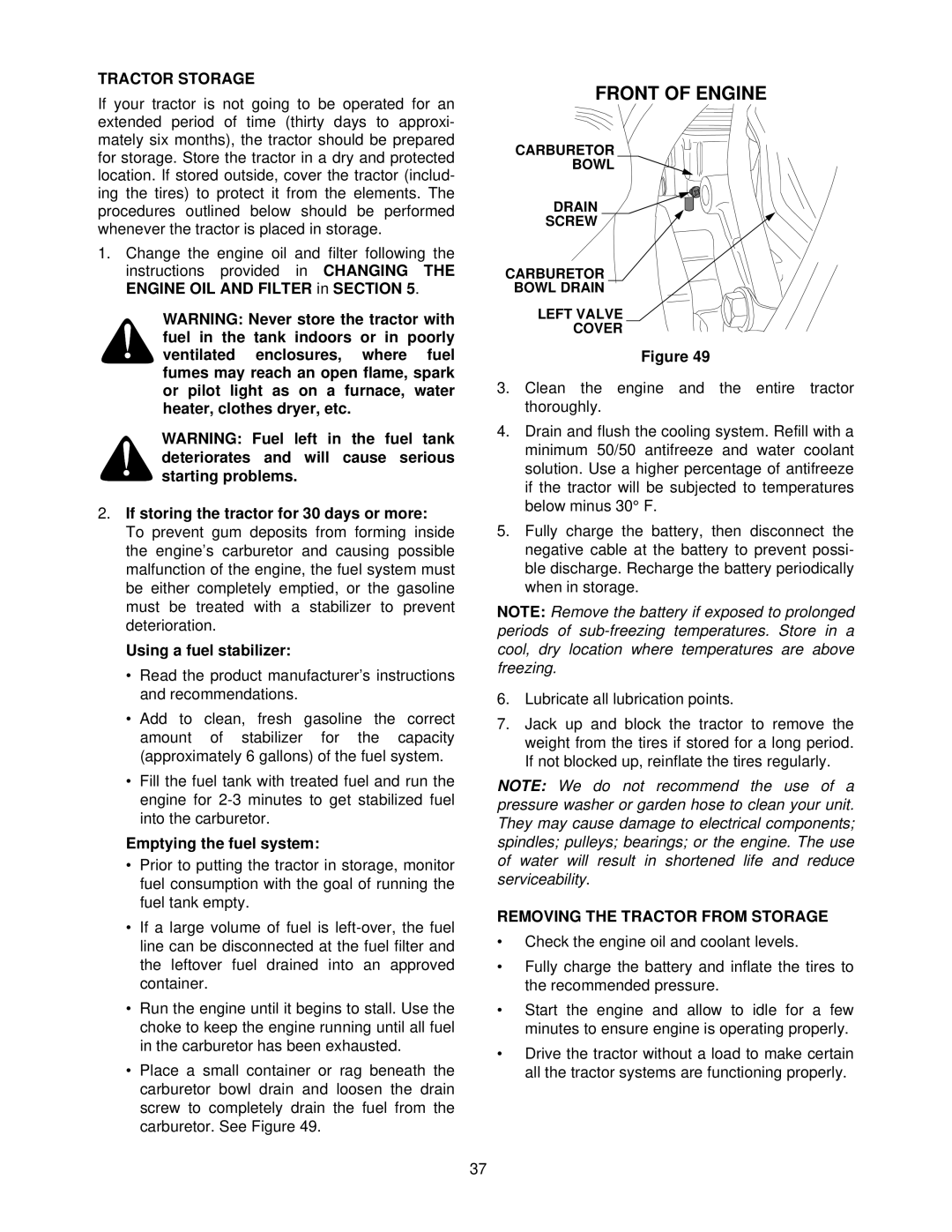
TRACTOR STORAGE
If your tractor is not going to be operated for an extended period of time (thirty days to approxi- mately six months), the tractor should be prepared for storage. Store the tractor in a dry and protected location. If stored outside, cover the tractor (includ- ing the tires) to protect it from the elements. The procedures outlined below should be performed whenever the tractor is placed in storage.
1.Change the engine oil and filter following the instructions provided in CHANGING THE ENGINE OIL AND FILTER in SECTION 5.
WARNING: Never store the tractor with fuel in the tank indoors or in poorly ventilated enclosures, where fuel fumes may reach an open flame, spark or pilot light as on a furnace, water heater, clothes dryer, etc.
WARNING: Fuel left in the fuel tank deteriorates and will cause serious starting problems.
2.If storing the tractor for 30 days or more:
To prevent gum deposits from forming inside the engine’s carburetor and causing possible malfunction of the engine, the fuel system must be either completely emptied, or the gasoline must be treated with a stabilizer to prevent deterioration.
Using a fuel stabilizer:
•Read the product manufacturer’s instructions and recommendations.
•Add to clean, fresh gasoline the correct amount of stabilizer for the capacity (approximately 6 gallons) of the fuel system.
•Fill the fuel tank with treated fuel and run the engine for
Emptying the fuel system:
•Prior to putting the tractor in storage, monitor fuel consumption with the goal of running the fuel tank empty.
•If a large volume of fuel is
•Run the engine until it begins to stall. Use the choke to keep the engine running until all fuel in the carburetor has been exhausted.
•Place a small container or rag beneath the carburetor bowl drain and loosen the drain screw to completely drain the fuel from the carburetor. See Figure 49.
FRONT OF ENGINE
CARBURETOR
BOWL
DRAIN
SCREW
CARBURETOR
BOWL DRAIN
LEFT VALVE
COVER
Figure 49
3.Clean the engine and the entire tractor thoroughly.
4.Drain and flush the cooling system. Refill with a minimum 50/50 antifreeze and water coolant solution. Use a higher percentage of antifreeze if the tractor will be subjected to temperatures below minus 30° F.
5.Fully charge the battery, then disconnect the negative cable at the battery to prevent possi- ble discharge. Recharge the battery periodically when in storage.
NOTE: Remove the battery if exposed to prolonged periods of
6.Lubricate all lubrication points.
7.Jack up and block the tractor to remove the weight from the tires if stored for a long period. If not blocked up, reinflate the tires regularly.
NOTE: We do not recommend the use of a pressure washer or garden hose to clean your unit. They may cause damage to electrical components; spindles; pulleys; bearings; or the engine. The use of water will result in shortened life and reduce serviceability.
REMOVING THE TRACTOR FROM STORAGE
•Check the engine oil and coolant levels.
•Fully charge the battery and inflate the tires to the recommended pressure.
•Start the engine and allow to idle for a few minutes to ensure engine is operating properly.
•Drive the tractor without a load to make certain all the tractor systems are functioning properly.
37
